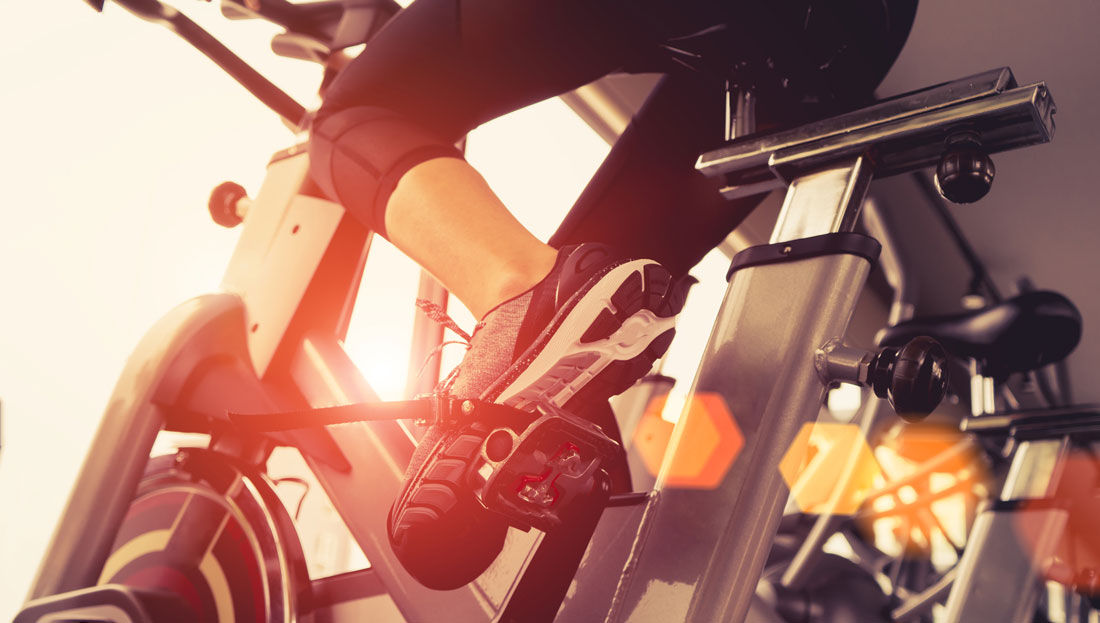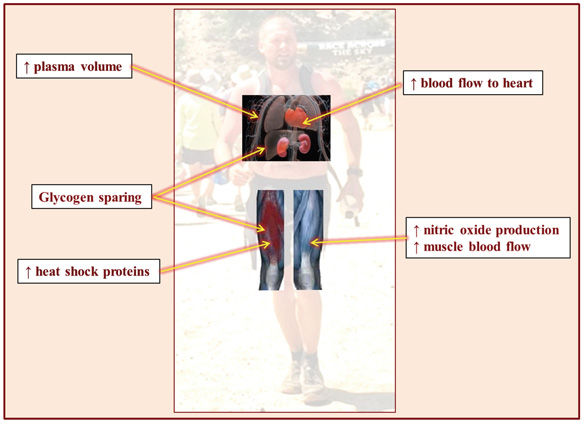
Over the past 25 years, I have designed programs for a wide range of individuals, from those who were disease-burdened to endurance athletes. By and large, the challenge remains remarkably similar across these diverse groups—to improve performance. Of course, performance goals vary from one client to the next; while one client may define enhanced performance as being able to more easily perform activities of daily living, another client may consider enhanced performance as a faster 10K race time.
So how do we improve performance? Clearly, how we manipulate volume and intensity of cardiorespiratory and muscular training plays an important role. Additionally, various nutritional recommendations can contribute to performance enhancement. However, it has been my experience that an often-overlooked strategy for improved performance is environmental stress.
The three most common forms of environmental stress that can be applied in conjunction with training are altitude, cold and heat. This article focuses specifically on how to make use of heat stress (or hyperthermic conditioning) to improve performance because it is accessible, convenient and portable. We’ll cover how hyperthermic conditioning works and the scientific evidence for a F.I.T.T. for hyperthermic conditioning. We’ll also identify key considerations and strategies for integrating hyperthermic conditioning into your clients’ training programs.
How Does Hyperthermic Conditioning Help Improve Performance?
Repeated exposure to hot and/or humid environmental conditions, which elicits an increase in both core temperature and sweating, leads to numerous physiological adaptations that ultimately reduce the deleterious effects of heat stress. This process is known as heat acclimatization or hyperthermic conditioning. The mechanisms of hyperthermic conditioning are multifactorial, and not only improve heat tolerance, but have the capacity to improve performance as well (Figure 1).
Increased Plasma Volume
One of the hallmark adaptations to heat stress is an increase in plasma volume (see Figure 1). Indeed, after only three to four days of acute heat exposure, plasma volume typically is increased about 5 to 15%. In turn, it is well known that increased plasma volume is an important factor mediating improvements in maximal oxygen uptake (VO2max). Given the robust relationship between VO2max and endurance performance, an increase in plasma volume signals an improved capacity for performance in endurance-related events.
Increased Nitric Oxide
Heat exposure leads to marked elevations in the potent vasodilator molecule known as nitric oxide. Increased concentrations of nitric oxide result in increased blood flow to both the heart and skeletal muscle (see Figure 1). Increased blood flow to the heart results in a lower heart rate for the same exercise workload, which makes it possible to exercise for longer periods in hot conditions. Increased blood flow to exercising skeletal muscle increases the delivery of various nutrients, including glucose, esterified fatty acids and, most importantly, oxygen. Improved delivery of glucose to skeletal muscle during exercise will spare liver and muscle glycogen by up to 50% (see Figure 1). The sparing of muscle glycogen equates to an enhanced ability to perform intense exercise.
Increased Heat Shock Proteins
Exposure to heat stress has been shown to increase the concentration of heat shock proteins (see Figure 1). Heat shock proteins scavenge free radicals, decrease damage to proteins from exercise-induced oxidative stress and increase antioxidants. Heat shock proteins can also promote increased red blood cell mass and capillary density. Overall, these adaptations contribute to improved oxygen-carrying capacity and better blood perfusion of the skeletal muscle bed during exercise and recovery.

Figure 1. The Mechanisms of Hyperthermic Conditioning
The Scientific Evidence for Hyperthermic Conditioning
Contemporary research has focused on how exercise, in conjunction with hyperthermic conditioning, can be used to improve overall exercise performance and health. Following are the findings of three ACE-supported research studies our team of researchers in the High Altitude Exercise Physiology Program at Western Colorado University has performed in recent years:
- Our first hyperthermic conditioning study in 2016 sought to determine the effectiveness of two weeks of training in a sauna suit on cardiorespiratory fitness (i.e., VO2max) and endurance performance. We recruited 14 people (12 men, two women) to participate in this study, half of whom were in the treatment group and half of whom were in the control group. Each individual had six or more years of endurance training and competition experience, and trained for seven to 12 hours each week. Prior to the onset of the study, the 14 participants underwent a battery of physiological and performance assessments. During one visit, they performed a maximal exercise test on a treadmill to measure their VO2max. During another visit, they completed a 5K time trial on a treadmill in a simulated hot environment (approximately 95° F/35° C). Participants were instructed to give maximal effort; the pace was initially set to each participant’s personal best in a 5K race. Finally, during a third visit to the lab, participants again completed a 5K time trial, this time in a temperate environment (approximately 64° F/18° C).
After completing the baseline testing, the participants were paired according to sex, VO2max and their personal best times on the 5K runs, and then randomized into the treatment and control groups so that the groups were as equal in terms of fitness level as possible. The design for the two-week period after the baseline testing could not have been simpler. The individuals who took part in this study were instructed to complete their usual training volume and intensity for 14 days and log all of their exercise. The only difference between the two groups was that the treatment group wore a Kutting Weight sauna suit during all workouts, while the control group did not. After two weeks, VO2max and 5K time trial performances in the control group remained unchanged. Alternatively, the treatment group experienced significant improvements in VO2max (+9.1%), 5K heat time trial (–4.1%) and 5K temperate time trial (–3.0%). The primary finding of this first hyperthermic conditioning study was that short-term training in a sauna suit improved heat acclimation and endurance performance. Additionally, we found that use of a sauna suit as a form of hyperthermic conditioning to enhance aerobic capacity and endurance performance was practical, portable and safe.
- Our second hyperthermic conditioning study in 2017 sought to determine the effectiveness of eight weeks of training in a sauna suit on cardiorespiratory fitness (i.e., VO2max) and cardiometabolic health. We recruited 45 participants with overweight or obesity between the ages of 18 and 60 years old to take part in the study. To qualify for participation, these individuals had to have a body mass index (BMI) between 25 and 40 kg/m2 and be sedentary, inactive and considered low-to-moderate risk. Participants were randomly divided into three groups: (1) a sauna suit group, (2) an exercise alone group and (3) a control group. Each week, the “sauna suit” and “exercise alone” groups performed three 45-minute moderate-intensity workouts and two 30-minute vigorous-intensity workouts. Moderate-intensity modalities varied among the elliptical, rower and treadmill, while the vigorous workouts were spin classes during which heart rates were monitored to ensure appropriate intensities. The only difference between the programs for these two groups was that one group wore a Kutting Weight sauna suit during the workouts, while the other did not.
There were several key areas where individuals wearing the sauna suit saw more dramatic improvements than their counterparts. Most importantly, the sauna suit group saw an 11.7% improvement in VO2max, compared to a 7.3% improvement in the exercise alone group. VO2max is considered the best indicator of cardiovascular endurance, so an increase in this one parameter is tremendously significant. Stated simply, this single measurement indicates that wearing the sauna suit enhanced physical fitness and improved health more than performing the same amount and intensity of exercise without wearing one. The sauna suit group also saw a 2.6% reduction in body weight compared to a 0.9% reduction in the exercise alone group. In addition, body fat decreased by 13.8% in the sauna suit group compared to 8.3% in the exercise alone group. The sauna suit group also experienced enhanced benefits compared to the exercise alone group in the following areas: fasting blood glucose (7.7% vs. 2.1% reduction), resting metabolic rate (an 11.4% improvement vs. a 2.7% decrease) and fat oxidation (3.8% increase vs. 2.6% decrease). Collectively, our findings demonstrated that hyperthermic conditioning with an affordable and portable sauna suit was an effective method for improving VO2max and cardiometabolic health for individuals who have overweight or obesity. Additionally, we found that wearing the sauna suit did not negatively affect exercise adherence, which is an important consideration when working with any client, but especially with those struggling to manage their weight.
- Our third and most recent hyperthermic conditioning study sought to examine the effects of two post-exercise passive heating strategies—wearing a sauna suit and hot water immersion—on VO2max, lactate threshold and exercise economy. The participants for this study were 30 men and women, ages 18 to 50, none of whom had more than one cardiometabolic risk factor (i.e., elevated blood pressure, blood lipids and/or blood glucose). The participants were randomized into three groups: (1) a control group that performed exercise training but did not use either of the passive heating strategies, (2) a group that performed exercise training with post-exercise hot water immersion and (3) a group that performed exercise training and wore a sauna suit post-exercise. At baseline and at the end of the study, all participants completed a running economy protocol that consisted of three stages of increasing speed: Stage 1 = 4.6 mph, Stage 2 = 5.0 mph, and Stage 3 = 5.4 mph. They also completed maximal exercise testing to measure VO2max and lactate threshold. Each participant’s first and second ventilatory threshold (VT1 and VT2) were also obtained during maximal exercise testing. All participants completed a standardized three-week training program. Three days a week (Monday, Wednesday and Friday), the participants performed moderate-intensity continuous training at VT1. One day a week (Tuesday), they performed high-intensity interval training at 100% of VO2max. And one day a week (Thursday), they performed steady-state training at VT2.
There were several key findings from this third hyperthermic conditioning study. First, both passive heating strategies (i.e., wearing a sauna suit or using hot water immersion for 30 minutes) following moderate-intensity continuous training led to statistically significant VO2max and lactate threshold changes. Secondly, both passive heating strategies were safe, as core body temperature levels remained well below thresholds linked with hyperthermia. Thirdly, and perhaps the most important finding of this study, is the practicality of the post-exercise passive heating approaches, as the improvements in endurance-related parameters were obtained with a minimal investment of additional time and no additional training volume or intensity.
Hyperthermic Conditioning – The Next Frontier in Exercise Programming
Here are some key considerations and strategies for integrating hyperthermic conditioning into your clients’ exercise programs.
1. What is the optimal FITT for hyperthermic conditioning?
As with any training paradigm, getting the various components of programming (e.g., frequency and intensity) correct is important for it to be effective, safe and well-tolerated. The FITT formula—which consists of frequency, intensity, time (duration) and type of exercise—is commonly used to design exercise programs. The same approach can be applied to hyperthermic conditioning. The FITT recommendations for hyperthermic conditioning based on findings from our three ACE-supported research studies are presented in Table 1.
Table 1. FITT for Hyperthermic Conditioning
| |
|
Program Component
|
Component Recommendation(s)
|
|
Frequency
|
|
|
Intensity
|
- Active hyperthermic conditioning during moderate-intensity workouts and
vigorous-intensity workouts
- Passive hyperthermic conditioning: hot water temperature = 102° F/39° C
|
|
Time (duration)
|
- Active hyperthermic conditioning duration = 20−30 minutes
- Passive hyperthermic conditioning duration = 30 minutes
- Duration of hyperthermic training block = 2−8 weeks
|
|
Type
|
- Active (during exercise) or passive (post-exercise)
- Artificial heat: hot water immersion, sauna suit
- Natural heat: hot/humid outdoor environmental conditions
|
2. Hyperthermic conditioning can prevent overtraining.
One of the most challenging aspects of training clients is to gradually increase volume and intensity in an effort to improve performance, without overtraining (or even injuring) the individual. Hyperthermic conditioning has the potential to accomplish the goal of improved performance much more easily and without the unwanted increased risk of overtraining. Given the findings of the studies discussed earlier, wearing a sauna suit during training can significantly amplify training adaptations—and this holds true for both performance- and health-related goals.
3. Many different types of clients can benefit from hyperthermic conditioning.
One aspect of hyperthermic conditioning I find to be quite appealing is the fact it can benefit various types of clientele. Clearly, a healthy client focused on performance can easily integrate hyperthermic conditioning into their routine. Alternatively, as presented earlier in the article, findings from one of our studies demonstrated that hyperthermic conditioning is safe and elicits substantial health benefits for those who are sedentary, inactive and/or risk factor–burdened individuals. That said, I don’t readily tell all gym-goers to jump into hyperthermic conditioning. The facility should be temperature controlled and clients should maintain proper hydration. Additionally, I generally don’t recommend hyperthermic conditioning in conjunction with interval training and/or longer duration workouts, as the risk of hyperthermia may increase.
4. Consider periodization of hyperthermic conditioning.
It is important to vary exercise programming throughout the calendar year to keep things fun, effective and safe. For these reasons, periodization of training is critical. It can also be applied to hyperthermic conditioning. For example, when tapering overall training volume prior to a key event, hyperthermic conditioning can be integrated into the overall training paradigm to maintain fitness. Another common scenario you likely encounter is when a client has to reduce their overall training/workout time due to work and family obligations. I have found hyperthermic condition in the form of wearing a sauna suit during several workouts a week to be a good solution. Because we know hyperthermic conditioning augments workouts, this strategy helps clients not lose any fitness or experience reductions in cardiometabolic health during episodes in their lives when less time is available for training.
5. Personalize hyperthermic conditioning to the client.
Another attractive feature of hyperthermic conditioning is that it need not follow a one-size-fits-all approach. For example, it can be active or passive. In other words, hyperthermic conditioning can take place during the workout (active) or post-exercise (passive). The duration of training to which hyperthermic conditioning can be applied may also vary from just a few weeks to months. Additionally, hyperthermic conditioning can be integrated using various modalities depending on client preference and availability. While this article focused primarily on sauna suits and hot tubs, other modalities of hyperthermic conditioning, such as saunas, environmental chambers and natural hot/humid outdoor settings, can also be effective. These options make it easier to personalize hyperthermic conditioning based on each client’s unique attributes, preferences and goals.
Final Thoughts
Hyperthermic conditioning confers numerous physiological adaptations that ultimately lead to various health and performance benefits. The ability to improve performance without increasing training volume or intensity makes it a particularly attractive option, as is the role it can play in active recovery. As a health and exercise professional, it is worth considering how you can apply the key considerations and strategies presented throughout this article to integrate hyperthermic conditioning into your clients’ exercise programs, as appropriate.





 by
by 



